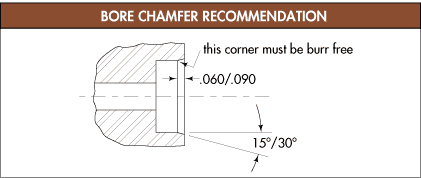|
|

  |
 |
 |
 BORE REQUIREMENTS BORE REQUIREMENTS
The same four factors which concern the shaft apply to the bore as well:
surface finish, hardness, chamfer, and tolerance.
 BORE FINISH BORE FINISH
A bore surface that is too rough may cause leakage between the bore
and the seal. Here are the maximum bore finishes recommended for metal
and rubber-covered outside diameter seals:

 BORE HARDNESS BORE HARDNESS
There is no minimum Rockwell hardness recommended for the bore.
However, steel and cast iron provide good bore surfaces for both rubber-
covered and metal OD seals. When the bore is of softer metals or plastic,
deVries International recommends using a rubber-covered rather than
a metal OD seal.
 BORE CHAMFER BORE CHAMFER
As with the shaft, a lead-in angle helps prevent damage during installation.
The diagram below shows recommended bore chamfer.

|
|
|
|






